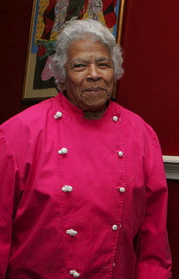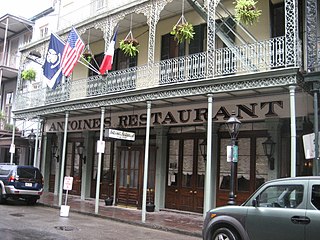
Arnaud's is a restaurant in the French Quarter of New Orleans, Louisiana, United States which serves classic Creole dishes. Established in 1918, it is one of the older and more famous restaurants in the city [1] .

Arnaud's is a restaurant in the French Quarter of New Orleans, Louisiana, United States which serves classic Creole dishes. Established in 1918, it is one of the older and more famous restaurants in the city [1] .

Arnaud's was founded in 1918 by a French wine salesman, Arnaud Cazenave. His daughter Germaine Wells took over management on his death in 1948 [3]
In 1978, 60 years after the restaurant was opened, it was bought by Archie and Jane Casbarian. The Casbarian family restored the restaurant back to its original roots, including renovating the building and updating the menu. These changes brought the restaurant positive recognition and widespread approval. [4]
The Germaine Cazenave Wells Mardi Gras Museum opened in 1983 and contains Mardi Gras artifacts all accumulated by Germaine Wells, [5] who died that year [6]
Arnaud's restaurant was one of the first local restaurants to reopen after Hurricane Katrina, which caused great damage in the Greater New Orleans area in August 2005, re-opening in November 2005. [7]
As of 2014 [update] Arnaud's is run by the fourth generation of the Casbarian family, Katy and Archie Casbarian, as well as their mother Jane. The family preserves the style of its founder, Arnaud Cazenave. Arnaud's signature dishes are also served at a more family-friendly cafe, "Remoulade", located nearby on Bourbon Street. [8] As of 2014, the head chef at Arnaud's was New Orleans local Tommy DiGiovanni. [9]
Arnaud's has 14 dining rooms: Mezzanine, Creole Cottage, Bourbon Suites, Edison Park, 1920, Iberville, Bienville, Toulouse, Dauphine, Lafitte, Bacchus, Gold, Irma, and Count's. Each room is furnished with a variety of antiques, chandeliers, and drapes, and can hold up to 220 people. [12]

Arnuad's serves classic Creole food. [13] Creole is an ethnic food of New Orleans, derived from French cuisine and typically includes butter, pepper, salt, and herbs. The base ingredients in Creole (like the related but different Cajun foods) are the "Holy Trinity", a mirepoix of onions, bell peppers, and celery, which is cooked in a roux of butter and flour. [14] The essence of Creole food is found in rich sauces, local herbs, red ripe tomatoes, and the prominent use of locally caught seafood. The cuisine may or may not be spicy.
Arnaud's has six menus: À La Carte Dinner Menu, Sunday Brunch and Jazz Menu, French 75 Menu, Table d'Hôte Menu, Dessert Menu, and Speakeasy. [15]
The dress code at Arnaud's is business casual. [16]
The French 75 Bar located next to the main dining room of Arnaud's was strictly a gentlemen-only area when the Cazenave family owned the restaurant. The bar reverted to its original name, French 75 Bar, after being renovated in 2003. [17] Arnaud's French 75 won the James Beard Award for outstanding bar program. [18]

Cajun cuisine is a style of cooking developed by the Cajun–Acadians who were deported from Acadia to Louisiana during the 18th century and who incorporated West African, French and Spanish cooking techniques into their original cuisine.

Louisiana Creole cuisine is a style of cooking originating in Louisiana, United States, which blends West African, French, Spanish, and Native American influences, as well as influences from the general cuisine of the Southern United States.

The holiday of Mardi Gras is celebrated in southern Louisiana, including the city of New Orleans. Celebrations are concentrated for about two weeks before and through Shrove Tuesday, the day before Ash Wednesday. Mardi Gras is French for Fat Tuesday, the season is known as Carnival and begins on 12th Night, January 6th, and extends until midnight before Ash Wednesday. Club, or Krewe, balls start soon after, though most are extremely private, with their Kings and Queens coming from wealthy old families and their courts consisting of the season's debutantes. Most of the high society Krewes do not stage parades. As Fat Tuesday gets nearer, the parades start in earnest. Usually there is one major parade each day ; many days have several large parades. The largest and most elaborate parades take place the last five days of the Mardi Gras season. In the final week, many events occur throughout New Orleans and surrounding communities, including parades and balls.

Calas are dumplings composed primarily of cooked rice, yeast, sugar, eggs, and flour; the resulting batter is deep-fried. It is traditionally a breakfast dish, served with coffee or cafe au lait, and has a mention in most Creole cuisine cookbooks. Calas are also referred to as Creole rice fritters or rice doughnuts.

Bourbon Street is a historic street in the heart of the French Quarter of New Orleans. Extending twelve blocks from Canal Street to Esplanade Avenue, Bourbon Street is famous for its many bars and strip clubs.

Rémoulade is a cold sauce. Although similar to tartar sauce, it is often more yellowish, sometimes flavored with curry, and often contains chopped pickles or piccalilli. It can also contain horseradish, paprika, anchovies, capers and a host of other items.

Paul Prudhomme, also known as Gene Autry Prudhomme, was an American celebrity chef whose specialties were Creole and Cajun cuisines, which he was also credited with popularizing. He was the chef proprietor of K-Paul's Louisiana Kitchen in New Orleans, and had formerly owned and run several other restaurants. He developed several culinary products, including hot sauce and seasoning mixes, and wrote 11 cookbooks.

Copeland's is a restaurant chain started by New Orleans native Al Copeland in 1983. It offers New Orleans-style cuisine and a casual sit-down family friendly atmosphere. Significantly expanding in the 1990s, it claimed more than 40 locations in 12 states and offered a "steakhouse"-style expanded menu by 2004. It then significantly retracted over the next few years, closing half their restaurants with only 12 locations remaining in four states, with over half of their locations in Louisiana. The following years showed expansion west into Texas while adding the Copeland's Cheesecake Bistro, Fire and Ice restaurants, and Al's Diversified Food & Seasonings – a line of specialty foods and spices for large national restaurant chains.

Red beans and rice is an emblematic dish of Louisiana Creole cuisine traditionally made on Mondays with Kidney beans, vegetables, spices and pork bones as left over from Sunday dinner, cooked together slowly in a pot and served over rice. Meats such as ham, sausage, and tasso ham are also frequently used in the dish. The dish is customary – ham was traditionally a Sunday meal and Monday was washday. A pot of beans could sit on the stove and simmer while the women were busy scrubbing clothes. The dish is now fairly common throughout the Southeast. Similar dishes are common in Latin American cuisine, including moros y cristianos, gallo pinto and feijoada.
Owen Edward Brennan Sr., was a restaurateur in his native New Orleans, Louisiana. In 1946 he founded the original Owen Brennan's Vieux Carre Restaurant on Bourbon St. Owen relocated his operations to 417 Royal St. The Royal St restaurant would soon be known as "Brennan's Restaurant," and opened shortly after Owen's sudden death in 1955.

Leyah (Leah) Chase was an American chef based in New Orleans, Louisiana. An author and television personality, she was known as the Queen of Creole Cuisine, advocating both African-American art and Creole cooking. Her restaurant, Dooky Chase, was known as a gathering place during the 1960s among many who participated in the Civil Rights Movement, and was known as a gallery due to its extensive African-American art collection. In 2018 it was named one of the 40 most important restaurants of the past 40 years by Food & Wine.

Antoine's is a Louisiana Creole cuisine restaurant located at 713 rue St. Louis in the French Quarter of New Orleans, Louisiana. It is one of the oldest family-run restaurants in the United States, having been established in 1840 by Antoine Alciatore. A New Orleans institution, it is notable for being the birthplace of several famous dishes, such as Oysters Rockefeller, pompano en papillote, Eggs Sardou and Pigeonneaux Paradis. Antoine's Cookbook, compiled by Roy F. Guste features hundreds of recipes from the Antoine's tradition. It is also known for its VIP patrons including several U.S. presidents and Pope John Paul II.

The culture of New Orleans is unique among, and distinct from, that of other cities in the United States, including other Southern cities. New Orleans has been called the "northernmost Caribbean city" and "perhaps the most hedonistic city in the United States". Over the years, New Orleans has had a dominant influence on American and global culture.

Roy Francis Guste Jr. was a New Orleans based author, photographer, and culinary historian. He wrote 10 Louisiana French-Creole cuisine cookbooks. Guste, a noted Creole historian and resident of the historic French Quarter of New Orleans for more than four decades, grew up in the Garden District, New Orleans and studied at the Le Cordon Bleu.

Broussard's, along with Galatoire's, Antoine's, and Arnaud's, is one of the four classic Creole New Orleans restaurants known as the Grand Dames.

The cuisine of New Orleans encompasses common dishes and foods in New Orleans, Louisiana. It is perhaps the most distinctively recognized regional cuisine in the United States. Some of the dishes originated in New Orleans, while others are common and popular in the city and surrounding areas, such as the Mississippi River Delta and southern Louisiana. The cuisine of New Orleans is heavily influenced by Creole cuisine, Cajun cuisine, and soul food. Later on, due to immigration, Italian cuisine and Sicilian cuisine also has some influence on the cuisine of New Orleans. Seafood also plays a prominent part in the cuisine. Dishes invented in New Orleans include po' boy and muffuletta sandwiches, oysters Rockefeller and oysters Bienville, pompano en papillote, and bananas Foster, among others.

Mr. B's Bistro is a restaurant in New Orleans, Louisiana, United States. Located in New Orleans' French Quarter, the restaurant is run by restaurateur Cindy Brennan.
Upperline Restaurant, or simply Upperline, was a fine dining restaurant in New Orleans, Louisiana, United States. Opened in 1983 by restaurateur JoAnn Clevenger, the restaurant was housed in a yellow townhouse located at 1413 Upperline Street in Uptown New Orleans near the St. Charles Streetcar Line. The restaurant focused on and was celebrated for mixing Cajun, Louisiana Creole, and Southern cuisine. Though Clevenger was not a chef, she developed Upperline's signature dish of fried green tomatoes with shrimp rémoulade, and inspired many other menu items. Upperline temporarily closed in March 2020 as a result of the COVID-19 pandemic. In November 2021, Clevenger announced the restaurant would not be reopening and that she and her family planned to sell the building and possibly the business.

Eat: An Oyster Bar is a Cajun and Louisiana Creole restaurant in Portland, Oregon.
Pableaux Johnson is a New Orleans-based writer, photographer, filmmaker, cook, and designer. His work focuses on the food and culture of New Orleans.